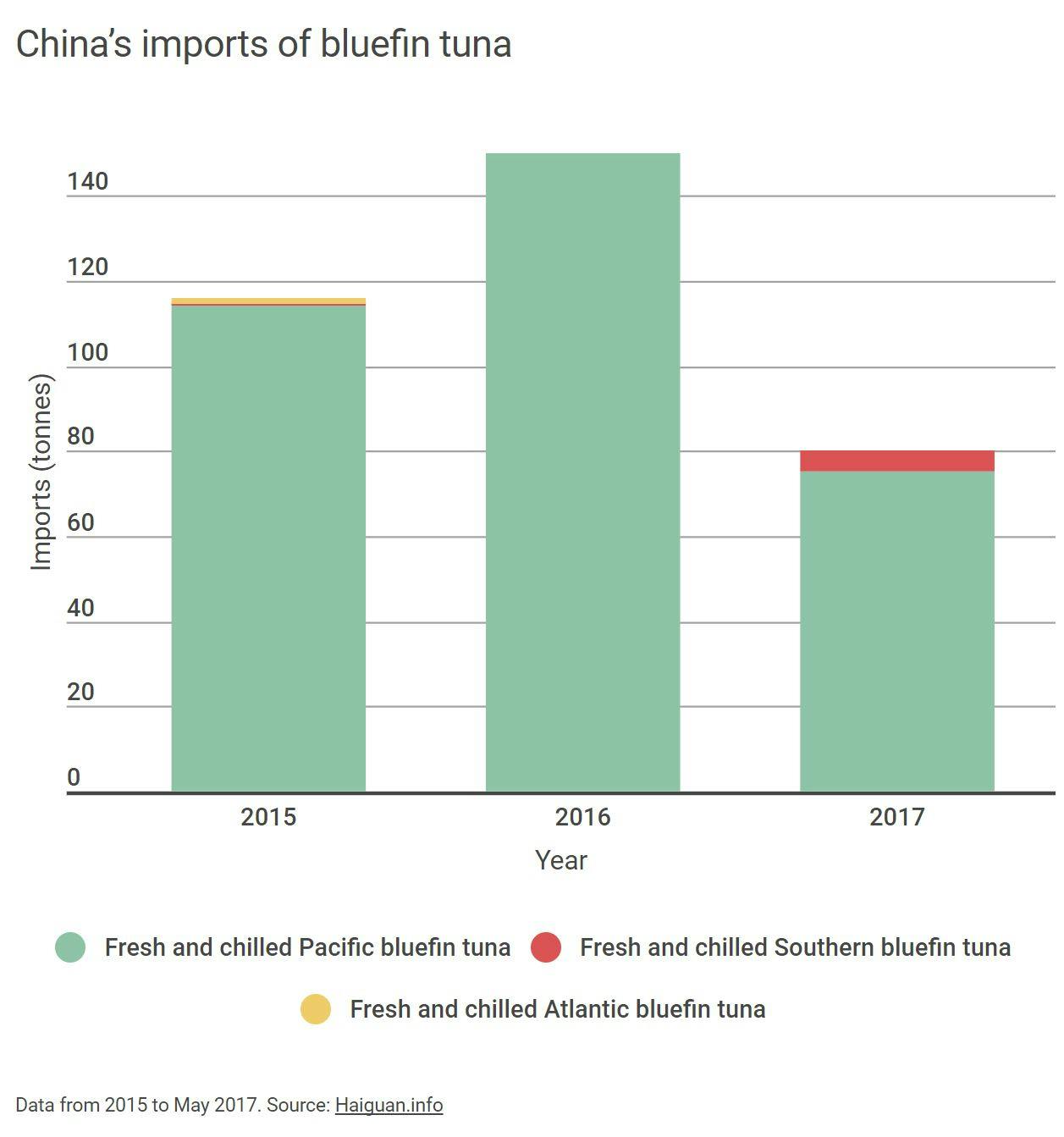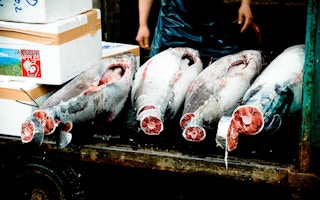JD.com, China’s second largest e-commerce platform, recently found itself making a swift and humiliating climbdown when a seafood product launch went spectacularly wrong, threatening its environmentally responsible image.
The e-commerce site’s CEO Liu Qiangdong signed a strategic partnership with the environmental campaign organisation World Wildlife Fund for Nature (WWF) China, pledging to promote “sustainable living” worldwide. The event took place on World Ocean’s Day.
Next morning, on June 9, Liu unveiled plans for JD.com to sell southern bluefin tuna that was sourced from Australia, priced at 300-800 yuan (US$44-118) per 100 grammes, depending on the cut. 800 yuan is roughly a week’s wage for many restaurant workers.
“
JD.com had not understood or fully prepared for the commitment to promote sustainable global supply chains and sustainable consumption.
Pan Wenjing, senior campaigner, Greenpeace East Asia
Red faces
Bluefin is the rarest, most expensive, and most endangered among tuna species. The three bluefin subspecies – Pacific, Atlantic and Southern – are all at risk, classed as vulnerable, endangered and critically endangered respectively by the International Union for Conservation of Nature (IUCN), though some experts think Atlantic bluefin populations may be recovering.
JD.com’s plans to market bluefin to China’s fine diners were quickly spotted by a sharp-eyed volunteer at China Biodiversity Conservation and Green Development Foundation (CBCDGF), an environmental NGO.
CBCGDF and three other local NGOs promptly contacted WWF, lobbying JD.com through WWF to remove bluefin tuna from sale.
Learning curve
To its credit, JD.com quickly agreed, banning sale of the fish on its platform, emphasising that it was selling farmed tuna, rather than wild-caught. The ban was a sign of its willingness to hold itself to a higher standard, it said.
Environmentalists have generally viewed the debacle as part of the company’s learning curve. Greenpeace East Asia senior campaigner Pan Wenjing said JD.com had not understood or fully prepared for the commitment to “promote sustainable global supply chains and sustainable consumption.”
Huang Shuya, who monitored the case for CBCGDF, praised JD.com’s quick response, while saying its hasty retreat suggested it had not anticipated such a large public reaction.
Trendsetter
JD.com’s dive for cover has caused ripples in the e-commerce sector. Taobao, China’s largest e-commerce site, and the online food giant Yhd.com, have both withdrawn bluefin tuna from sale.
Nonetheless, a number of small venders on the giant Taobao platform are offering “black tuna,” another name for bluefin.
Overall sales of bluefin tuna are rising in China in line with growing demand for luxury seafood. This raises the possibility that bluefin could fill the market gap created by the ban on shark fin soup.
There is no sign yet though that the controversy and high-profile bans on online sales are dampening sales through other channels.
Fashionable fish
The growing spending power of China’s middle class has led to a shift in food tastes, with expensive imported foods and foreign cuisines increasingly popular. Rising interest in Japanese food has also created enthusiasm for bluefin tuna sashimi.
In 2015, high-end Japanese restaurants in China started holding “first bluefin tuna cutting ceremonies,” publicity stunts modelled on ceremonies at Tokyo’s famous Tsukiji fish market and elsewhere in Japan.
E-commerce platforms have also sought to ramp up sales of imported luxury foods. Taobao CEO Jack Ma led the way, splashing 38,888 yuan (US$5,700) on the high-profile purchase of a 68 kilogramme (kg) bluefin tuna in November 2015. The lavish, much photographed feast was the first time many Chinese consumers had heard of bluefin tuna.
Japan is the main consumer
Overall consumption remains low though. Japanese restaurants are a niche market in China. Bluefin tuna is expensive, eaten mostly by the wealthy in coastal cities with strong seafood cuisine traditions, or in China’s major inland cities.
Chinese consumers ate up to 220 tonnes of bluefin tuna in 2016 although China’s customs data shows imports rose 37 per cent that year.
Japan accounts for 80 per cent of the global bluefin catch. Chinese fleets are limited to hunting Atlantic bluefin under catch quota rules, so importers must buy Pacific and Southern bluefin from other fleets.
In 2016, imports hit 158 tonnes, topped up by China’s Atlantic bluefin quota of 53.9 tonnes – or less than 1 per cent of the 2016 catch of Atlantic bluefin.
Farm it or ban it?
The sales ban by e-retailers has not ended controversy over commercial farming of endangered wild species. Supporters say with protection measures in place moderate consumption is fine. Opponents argue that consumption risks stimulating demand, undercutting conservation measures.
Fan Xubing, founder of food website newsavour.com, told chinadialogue that total opposition to eating bluefin tuna was unrealistic: “You should steer people towards eating farmed fish, while better monitoring endangered populations.” He sees a choice between consumption and conservation as overly simplistic.
JD.com planned to import farmed fish. While farmed supplies remain too small to replace wild fish, Fan believes expanding bluefin farming could reduce pressure on wild populations. He compares it how salmon farming developed “to meet consumer demand after overfishing.”
However, conservationists maintain that farming will not stop overfishing of other species because farmed bluefin are fed young wild-caught fish. A bluefin tuna needs 15kg of fodder to gain 1kg in weight.
Replacement for shark fin?
China’s huge demand for prestige foods like shark fin and sea cucumber has conservationists worried that overfishing of bluefin tuna will worsen. They are concerned that bluefin will fill a gap in the market left by successful campaigns against eating shark fin.

Bluefin is not part of traditional Chinese cuisine. Yet there is cause of concern. Import data shows rapid increases in the three years since campaigners declared victory in the battle to cut consumption of shark fin.
Michael Fabinyi, a senior research fellow at the School of Communication at the University of Technology Sydney, studies luxury seafood eating habits in China. As the overall market is enormous, and growing, he expects bluefin consumption to rise.
Shark fin sales plummeted after a government ban on eating them at public banquets, coupled with consumer fears about fakes. However, the case of sea cucumbers suggests that NGO awareness campaigns alone are insufficient. “Lots of sea cucumber species are endangered,” said Fabinyi, adding “but that’s still a very popular food in China.”
Critical moment
Sasha Issenberg, who wrote ‘The Sushi Economy,’ recounts an interview with Masanori Miyahara, president of Japan’s Fisheries Research Agency who said spawning stocks of Pacific bluefin were near historic lows. The agency cut catches of young fish and called for consumer restraint, but Japanese consumers proved unsupportive.
Hu Tao, director of the China Program at WWF’s Washington Office, says a fast-growing middle class means China’s consumption “is even likely to outstrip Japan, if this trend is not controlled.” The global bluefin tuna catch would have to double for that to happen.
As eating bluefin remains a niche taste in China, Fabinyi’s view is that higher sales would need more marketing, making JD.com’s decision to halt sales and marketing of bluefin a significant step towards controlling consumption.
Intern Li Jinxue also contributed to this article.
This story was originally published by Chinadialogue under a Creative Commons’ License and was republished with permission.








